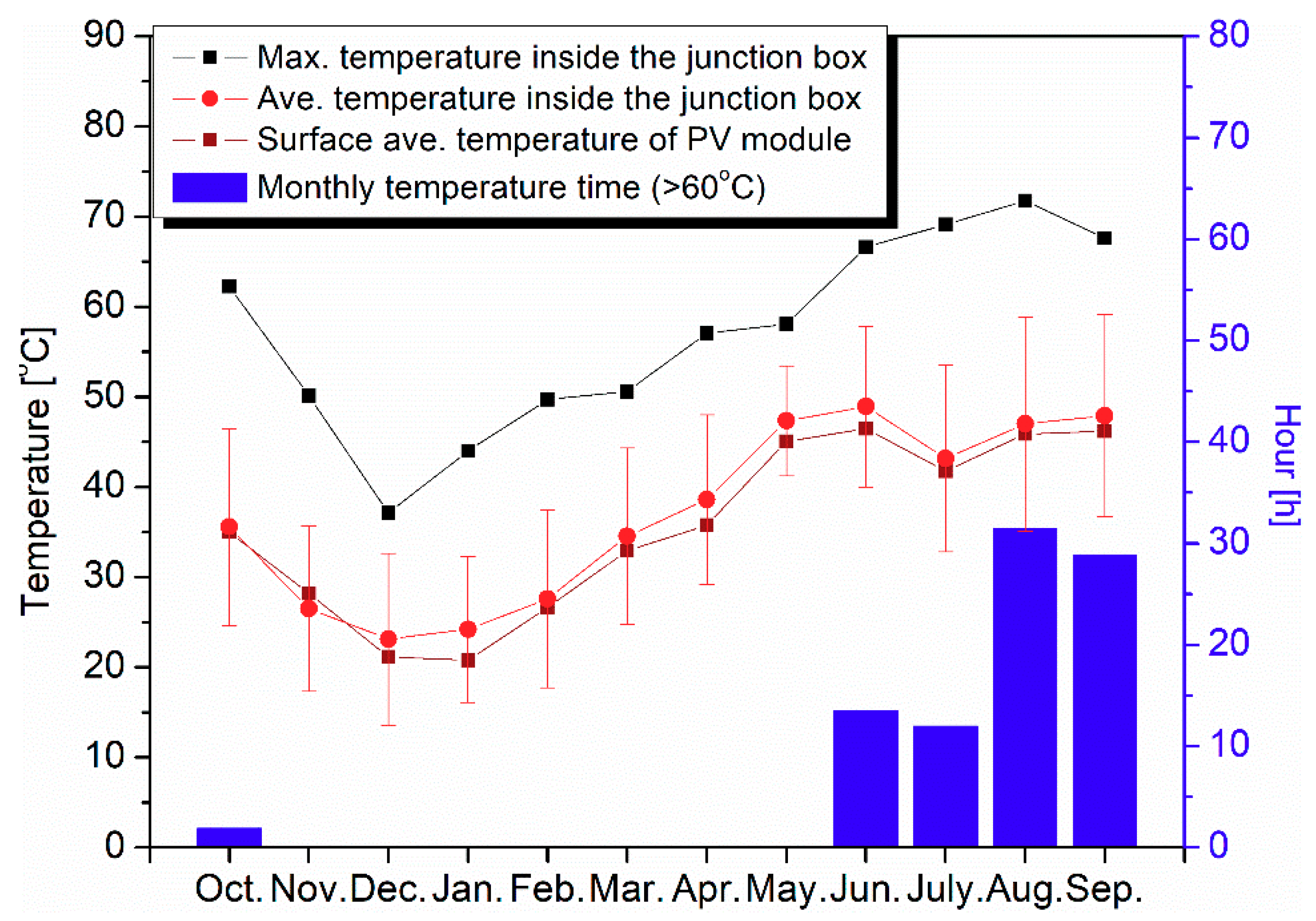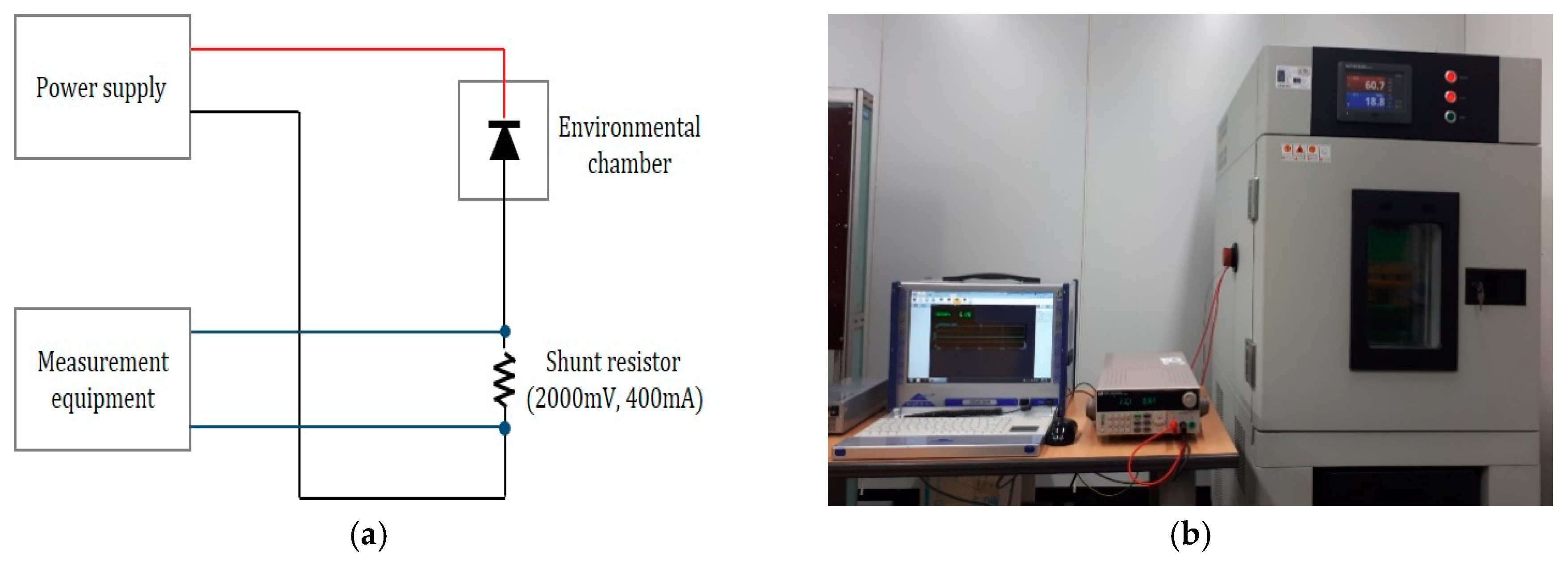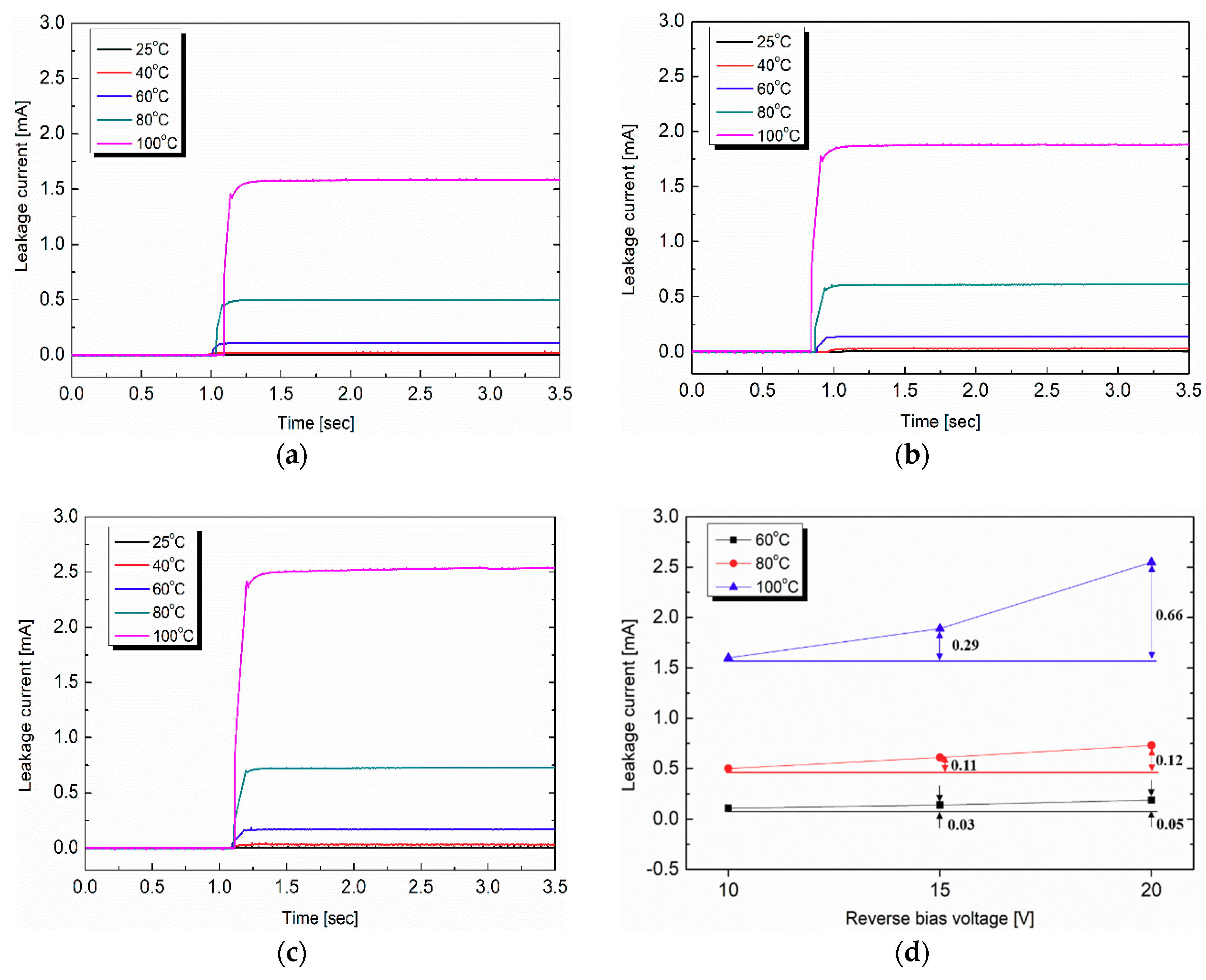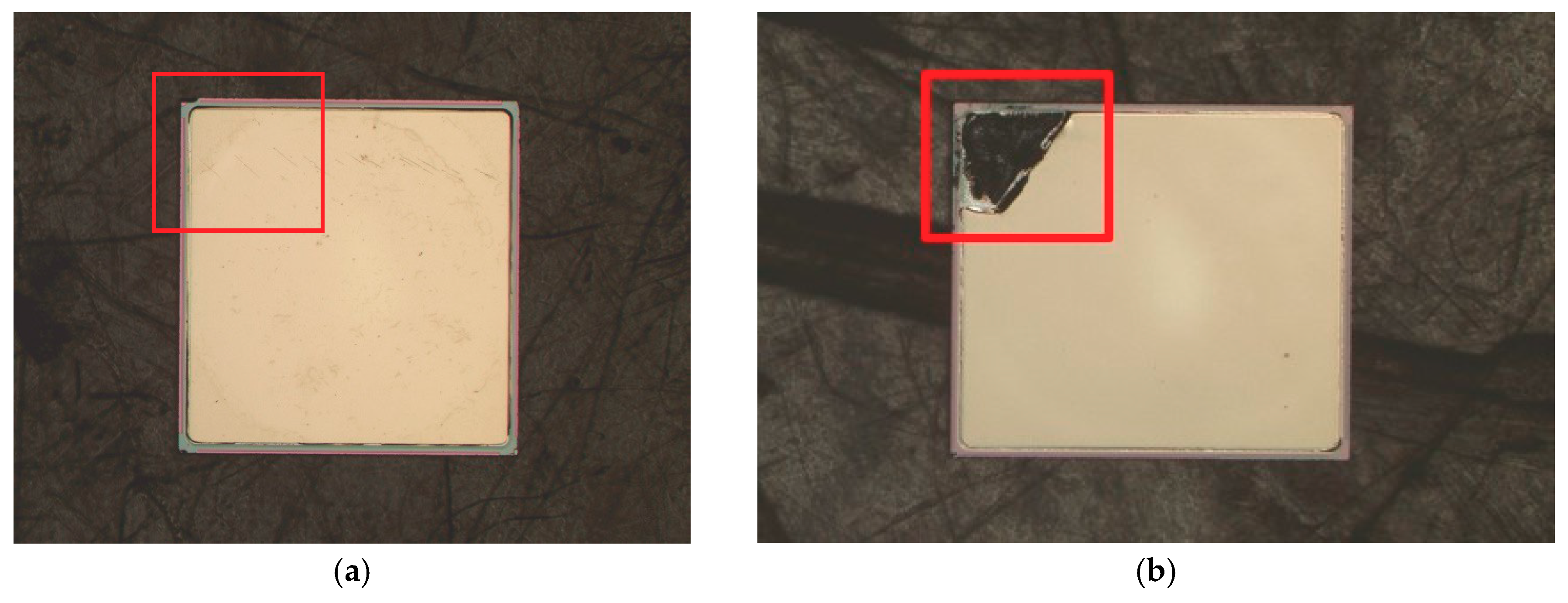Origin of Bypass Diode Fault in c-Si Photovoltaic Modules: Leakage Current under High Surrounding Temperature
Abstract
:1. Introduction
2. Electrical Characteristics of Schottky Type Bypass Diode
3. Temperature in the Junction Box of a c-Si PV Module Installed Outside
4. Continuous Leakage Current of the Bypass Diode at Different Temperature
5. Failure Detection and Analysis of Damaged Bypass Diodes
5.1. Detection of Bypass Diode Failure in the Field
5.2. Analysis of Failed Bypass Diode
6. Conclusions
Author Contributions
Acknowledgments
Conflicts of Interest
References
- Meyer, E.L.; Van Dyk, E.E. The effect of reduced shunt resistance and shading on photovoltaic module performance. In Proceedings of the Conference Record of the 31st IEEE Photovoltaic Specialists Conference, Lake Buena Vista, FL, USA, 3–7 January 2005; pp. 1131–1334. [Google Scholar]
- Simon, M.; Meyer, E.L. Detection and analysis of hot-spot formation in solar cells. Sol. Energy Mater. Sol. Cells 2010, 94, 106–113. [Google Scholar] [CrossRef]
- Vrmuru, S.; Singh, P.; Niamat, M. Modeling impact of bypass diodes on photovoltaic cell performance under partial shading. In Proceedings of the 2012 IEEE International Conference on Electro/Information Technology, Indianapolis, IN, USA, 6–8 May 2012; pp. 1–5. [Google Scholar]
- Kim, S.T.; Kang, G.H.; Park, J.H.; Ahn, H.K.; Yu, G.J.; Han, D.Y. The electrical characteristics of shading effect in Photovoltaic module. J. Korean Sol. Energy Soc. 2008, 4, 257–262. [Google Scholar]
- Almaktar, M.; Rahman, H.A.; Hassan, M.Y. Effect of loss resistances, module temperature variation, and partial shading on PV output power. In Proceedings of the 2012 IEEE International Conference on Power and Energy (PECon), Kota Kinabalu, Malaysia, 2–5 December 2012; pp. 360–365. [Google Scholar]
- Brooks, A.E.; Cormode, D.; Cronin, A.D.; Kam-lum, E. PV system power loss and module damage due to partial shade and bypass diode failure depend on cell behavior in reverse bias. In Proceedings of the 2015 IEEE 42nd Photovoltaic Specialist Conference (PVSC), New Orleans, LA, USA, 14–19 June 2015; pp. 1–6. [Google Scholar]
- Wang, Y.J.; Hsu, P.S. An investigation on partial shading of PV modules with different connection configuration of PV cells. Energy 2011, 35, 3069–3078. [Google Scholar] [CrossRef]
- Al-Rawi, N.A.; Al-Kaisi, M.M.; Asfer, D.J. Reliability of photovoltaic modules II. Interconnections and bypass diodes effects. Sol. Energy Mater. Sol. Cells 1994, 31, 469–480. [Google Scholar] [CrossRef]
- Silvestre, S.; Boronat, A.; Chouder, A. Study of bypass diodes configuration on PV module. Appl. Energy 2009, 86, 1632–1640. [Google Scholar] [CrossRef]
- Duong, M.Q.; Sava, G.N.; Ionescu, G.; Necula, H.; Leva, S.; Mussetta, M. Optimal bypass diode configuration for PV arrays under shading influence. In Proceedings of the 2017 IEEE International Conference on Environment and Electrical Engineering and 2017 IEEE Industrial and Commercial Power Systems Europe (EEEIC/I&CPS Europe), Milan, Italy, 6–9 June 2017; pp. 1–5. [Google Scholar]
- Daliento, S.; Di Napoli, F.; Guerriero, P.; d’Alessandro, V. A modified bypass circuit for improved hot spot reliability of solar panels subject to partial shading. Sol. Energy 2016, 134, 211–218. [Google Scholar] [CrossRef]
- Bauwens, P.; Doutreloigne, J. Reducing partial shading power loss with an intergrated Smart Bypass. Sol. Energy 2014, 103, 134–142. [Google Scholar] [CrossRef]
- Parlak, K.S. PV array reconfiguration method under partial shading conditions. Electr. Power Energy Syst. 2014, 63, 713–721. [Google Scholar] [CrossRef]
- Belhaouas, N.; Cheikh, M.S.A.; Agathoklis, P.; Oularbi, M.R.; Amrouche, B.; Sedraoui, K.; Djilali, N. PV array power output maximization under partial shading using new shifted PV array arrangement. Appl. Energy 2017, 187, 326–337. [Google Scholar] [CrossRef]
- Lim, J.R.; Min, Y.K.; Jung, T.H.; Ahn, J.H.; Ahn, H.K. Correlation between reverse voltage characteristics and bypass diode operation with different shading conditions for c-Si photovoltaics module package. J. Semicond. Technol. Sci. 2015, 15, 577–584. [Google Scholar] [CrossRef]
- Alonso-Garcia, M.C.; Ruiz, J.M. Analysis and modelling the reverse characteristic of photovoltaic cells. Sol. Energy Mater. Sol. Cells 2006, 90, 1105–1120. [Google Scholar] [CrossRef]
- Jung, T.H.; Go, J.W.; Kang, G.H.; Ahn, H.K. Output Characteristics of PV module Considering Partially Reverse Biased Conditions. Sol. Energy 2013, 92, 214–220. [Google Scholar] [CrossRef]
- Bai, J.; Cao, Y.; Hao, Y.; Zhang, Z.; Liu, S.; Cao, F. Characteristic output of PV systems under partial shading or mismatch conditions. Sol. Energy 2015, 112, 41–54. [Google Scholar] [CrossRef]
- Moreira, H.S.; e Oliveira, T.P.; dos Reis, M.V.G.; Guerreiro, J.F.; Villalva, M.G.; de Siqueira, T.G. Modeling and simulation of photovoltaic systems under non-uniform conditions. In Proceedings of the 2017 IEEE 8th International Symposium on Power Electronics for Distributed Generation Systems (PEDG), Florianopolis, Brazil, 17–20 April 2017; pp. 1–6. [Google Scholar]
- Haeberlin, H. Damages at bypass diodes by induced voltages and currents in PV modules caused by nearby lightning currents. In Proceedings of the 22nd European Photovoltaic Solar Energy Conference and Exhibition, Milan, Italy, 3–7 September 2007. [Google Scholar]
- Haeberlin, H. Interference Voltages induced by Magnetic Fields of Simulated Lightning Currents in Photovoltaic Modules and Arrays. In Proceedings of the 17th European Photovoltaic Solar Energy Conference and Exhibition, Munich, Germany, 22–26 October 2001. [Google Scholar]
- Dhere, N.G.; Shiradkar, N.; Schneller, E.; Gade, V. The reliability of bypass diodes in PV modules. Reliab. Photovolt. Cells Modul. Compon. Syst. VI 2013, 8825, 882501. [Google Scholar]
- Posbic, J.; Rhee, E.; Amin, D. High Temperature Reverse By-Pass Diodes Bias and Failures. Available online: https://www.energy.gov/sites/prod/files/2014/01/f7/pvmrw13_ps3_memc_posbic.pdf (accessed on 1 Febrary 2013).
- Köntges, M.; Kurtz, S.; Packard, C.; Jahn, U.; Berger, K.A.; Kato, K.; Friesen, T.; Liu, H.T.; Van Iseghem, M. Review of Failures of Photovoltaic Modules; IEA PVPS Task 13; International Energy Agency: Paris, France, 2014. [Google Scholar]
- Köntges, M.; Oreski, G.; Jahn, U.; Herz, M.; Hacke, P.; Weiss, K.A.; Razongles, G.; Paggi, M.; Parlevliet, D.; Tanahashi, T.; et al. Assessment of Photovoltaic Module Failures in the Field; International Energy Agency: Paris, France, 2017. [Google Scholar]
- Shin, W.G.; Jung, T.H.; Ko, S.W.; Ju, Y.C.; Chang, H.S.; Kang, G.H. Analysis on thermal & electrical characteristics variation of PV module with damaged bypass diodes. J. Korean Sol. Energy Soc. 2015, 35, 67–75. [Google Scholar] [Green Version]
- Ko, S.W.; Ju, Y.C.; Hwang, H.M.; So, J.H.; Jung, Y.S.; Song, H.J.; Song, H.E.; Kim, S.H.; Kang, G.H. Electrical and thermal characteristics of photovoltaic modules under partial shading and with a damaged bypass diode. Energy 2017, 128, 232–243. [Google Scholar] [CrossRef]
- Anderson, B.L.; Anderson, R.L. Fundamentals of Semiconductor Devices (Korea Language Edition); McGraw-Hill Education: Seoul, Korea, 2005; pp. 347–355. [Google Scholar]
- Streetman, B.G.; Banerjee, S. Solid State Electronic Devices, 5nd ed.; Prentice Hall: New Jersey, NJ, USA, 1999; pp. 220–224. [Google Scholar]
- Ko, S.W.; Ju, Y.C.; So, J.H.; Hwang, H.M.; Jung, Y.S.; Kang, G.H. The characteristics of PV module under partial shading condition and with a failure of bypass diode with short. J. Korean Sol. Energy Soc. 2016, 36, 41–47. [Google Scholar] [CrossRef]









| Peak Average Leakage Current (mA) | |||
|---|---|---|---|
| Temperature. | 10 V | 15 V | 20 V |
| 25 °C | 0.01 | 0.01 | 0.02 |
| 40 °C | 0.04 | 0.04 | 0.05 |
| 60 °C | 0.11 | 0.14 | 0.19 |
| 80 °C | 0.50 | 0.61 | 0.73 |
| 100 °C | 1.60 | 1.89 | 2.55 |
© 2018 by the authors. Licensee MDPI, Basel, Switzerland. This article is an open access article distributed under the terms and conditions of the Creative Commons Attribution (CC BY) license (http://creativecommons.org/licenses/by/4.0/).
Share and Cite
Shin, W.G.; Ko, S.W.; Song, H.J.; Ju, Y.C.; Hwang, H.M.; Kang, G.H. Origin of Bypass Diode Fault in c-Si Photovoltaic Modules: Leakage Current under High Surrounding Temperature. Energies 2018, 11, 2416. https://doi.org/10.3390/en11092416
Shin WG, Ko SW, Song HJ, Ju YC, Hwang HM, Kang GH. Origin of Bypass Diode Fault in c-Si Photovoltaic Modules: Leakage Current under High Surrounding Temperature. Energies. 2018; 11(9):2416. https://doi.org/10.3390/en11092416
Chicago/Turabian StyleShin, Woo Gyun, Suk Whan Ko, Hyung Jun Song, Young Chul Ju, Hye Mi Hwang, and Gi Hwan Kang. 2018. "Origin of Bypass Diode Fault in c-Si Photovoltaic Modules: Leakage Current under High Surrounding Temperature" Energies 11, no. 9: 2416. https://doi.org/10.3390/en11092416




